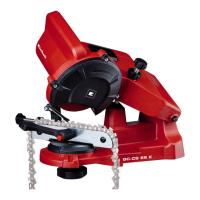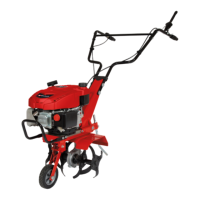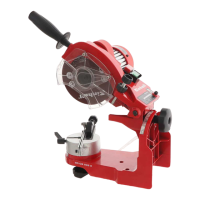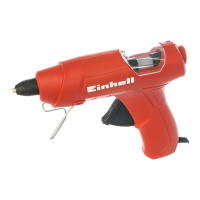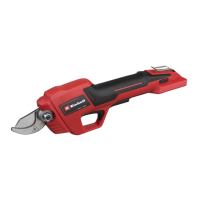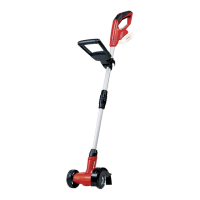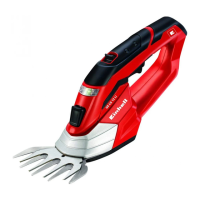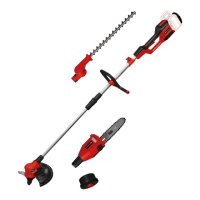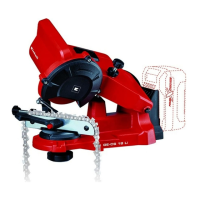GB
- 30 -
Sawing
The equipment is not suitable for sawing.
Jamming
If the cutting blade jams as a result of attempting
to cut vegetation that is too dense, switch off the
engine immediately. Remove the grass and scrub
from the equipment before you restart it.
Preventing recoil
When you work with the blade, there is a risk of
recoil if it strikes solid objects such as tree trunks,
branches, tree stumps, stones or the like. This will
throw the equipment backwards in the direction
opposite to the rotation of the tool. This can cause
you to lose control of the equipment. Do not use
the blade near fences, metal posts, boundary
stones or foundations. For cutting dense stalks,
position the blade as shown in Fig. 9f to prevent
recoil.
9. Maintenance
Always switch off the equipment and pull out the
spark boot plug before carrying out any mainte-
nance work.
9.1 Replacing the line spool/cutting line
1. Dismantle the line spool (13) as described in
section 5.1.6. Press the spool together (Fig.
12a) and remove one half of the housing (Fig.
12b).
2. Take the line spool out of the line spool
housing (Fig. 12c).
3. Remove any remaining cutting line.
4. Place the new cutting line in the center and
attach the resulting loop to the recess in the
spool splitter (Fig. 12d).
5. Wind the line on to the spool counter-clockwi-
se with tension. The spool splitter will separa-
te the two halves of the nylon line (Fig. 12e).
6. Hook the last 15 cm of the two ends of the
line to the line holders opposite the line spool
(Fig. 12f).
7. Thread the two ends of the line through the
metal eyelets in the line spool housing (Fig.
12c).
8. Press the line spool into the line spool
housing.
9. Pull the two line ends sharply to release them
from the line holders.
10. Cut the excess line to a length of around 13
cm. This will reduce the load on the engine
when starting up and warming up.
11. Fit the line spool again. See section 5.1.6. If
you are replacing the complete line spool,
ignore points 3-6.
9.2 Grinding the safety hood blade
The safety hood blade can become blunt over
time. When you notice this, undo the screw hol-
ding the safety hood blade on the safety hood.
Clamp the blade in a vise. Sharpen the blade with
a fl at fi le and make sure that the angle of the cut-
ting edge is not altered in the process. File in one
direction only.
9.3 Maintenance of the air fi lter (Fig. 10a-10c)
Soiled air fi lters reduce the engine output by sup-
ply too little air to the carburetor. Regular checks
are therefore essential. The air fi lter (10) should
be checked after every 25 hours of use and clea-
ned if necessary. If the air contains a lot of dust,
the air fi lter should be checked more frequently.
1. Remove the air fi lter cover (Fig. 10a).
2. Remove the fi lter element (Fig. 10b/10c).
3. Clean the fi lter element by tapping it or
blowing it.
4. Assemble in reverse order.
Important: Never clean the air fi lter with petrol or
infl ammable solvents.
9.4 Maintenance of the spark plug
(Fig. 11a-11c)
Spark plug sparking gap = 0.6mm. Tighten the
spark plug with a torque of 12 to 15 Nm. Check
the spark plug for dirt and grime after 10 hours of
operation and if necessary clean it with a copper
wire brush. Thereafter service the spark plug after
every 50 hours of operation.
1. Remove the spark plug connector cover (20)
as shown in Fig. 11a.
2. Pull out the spark plug connector (16). (Fig.
11b)
3. Remove the spark plug (Abb. 11c) with the
supplied spark plug wrench (27).
4. Assemble in reverse order.
9.5 Carburetor settings
Important. Settings on the carburetor may only be
made by authorized customer service personnel.
To carry out any work on the carburetor you must
fi rst remove the air fi lter cover as shown in Figu-
res 10a-10c.
Anl_SA_GC_BC_52_I_AS_SPK8.indb 30Anl_SA_GC_BC_52_I_AS_SPK8.indb 30 11.01.2017 09:16:2411.01.2017 09:16:24
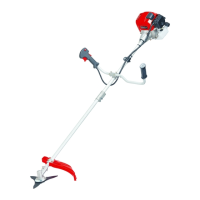
